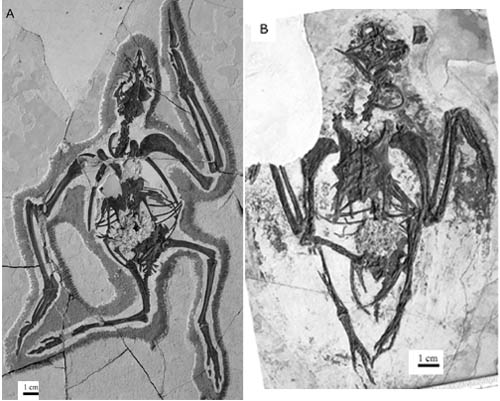| Location: Home > Research > Research Progress |
| New Specimens Provide Anatomical Features for the Cretaceous Basal Ornithuromorph Bird |
|
Most ornithuromorph birds from the Jehol Group are based on single specimens, or represented by fairly fragmentary materials. As one of the earliest-known beaked ornithuromorph birds, Archaeorhynchus spathula is important for understanding the early evolution of this derived avian clade. Recently, two new complete and articulated skeletons of Archaeohyrnchus spathula with large aggregates of gastroliths in the abdominal areas were collected from Lower Cretaceous deposits of Jianchang, Liaoning, northeastern China. Paleontologists from Institute of Vertebrate Paleontology and Paleoanthropology (IVPP), Chinese Academy of Sciences, revealed many important characters that were either unknown or misinterpreted in the previous study. As the only known non-adult ornithuromorph specimens from the Jehol Group, Archaeohyrnchus alsoprovides important information regarding the ontogeny of this group. Researchers reported in the Journal of Vertebrate Paleontology 33(1). Archaeorhynchus spathula was first reported in 2006 as a medium-sized basal ornithuromorph bird. It was collected from the Yixian Formation (125 Ma), in Yixian, Liaoning Province. It is distinguishable from other Mesozoic ornithuromorphs by the unique combination of characters. Among known early ornithuromorph birds, the sternum displays a wide range of morphologies. In the new specimens of Archaeorhynchus, the sternum is not markedly elongated, being slightly shorter than wide, and the imperforate region is very short, due to the deep caudal incisions closed by the caudal trabeculae. The sternum is similar to that of the second known ornithuromorph (unnamed) from the Xiagou Formation, Gansu Province. In one of the new specimens, the carpals are well preserved. The carpal composition of Archaeorhynchus resembles that of Archaeopteryx, consisting of four carpals: the proximal ulnare and radiale, the distal semilunate, and ‘carpal X’. Embryological evidence from modern birds reveals that the semilunate carpal is centered on the major metacarpal. In this new specimen, it is clear that the proximal end of the minor metacarpal lies distal to that of the major metacarpal, whereas ‘carpal X’ is preserved between the proximal end of the minor metacarpal and the semilunate bone. This observation indicates that, in ornithuromorphs, the semilunate carpal and ‘carpal X’ become fused to the proximal ends of the metacarpals, as in enantiornithines. The new specimen clearly show that the distal tarsals are fused together to form a cap, rather than first fusing with the proximal end of the unfused metatarsals, supporting the argument that tarsometatarsal development in fossil ornithuromorphs is assumed to have progressed similarly to modern birds, with a distal tarsal cap forming prior to its fusion with the proximal ends of metatarsals II–IV. In previous cladistic analyses, Archaeorhynchus was typically resolved as a basal ornithuromorph taxon more derived than enantiornithines and most closely related to known ornithuromorphs. This study indicates that Archaeorhynchus displays a mosaic of characters, as shown in other basal ornithuromorphs. Like other more derived avians, Archaeorhynchus has a ‘U’-shaped furcula, a keel extending along the full length of the sternum, a globose humeral head, and a dorsoventrally compressed and caudally expanded first phalanx of the major manual digit. However, as one of the most basal ornithuromorphs, Archaeorhynchus also retains several primitive features, such the dentary not being strongly forked posteriorly (it is forked in Apsaravis), and deep caudal notches in the sternum, which are present in enantiornithines. Information regarding early developmental stages in fossil birds is of great value for studying early avian evolution. Non-adult specimens of Mesozoic ornithuromorphs are extremely rare although they are quite common among enantiornithines. Because the vertebrae and the extremities of many long bones are not well ossified (e.g., coracoid, humerus, and femur) or fused (e.g., carpometacarpus and tarsometatarsal bones), both specimens are considered to be subadult. As the only known non-adult ornithuromorph record from the Jehol Group, Archaeorhynchus spathula provide a rare and unique glimpse into the ontogenetic development of Archaeorhynchus and basal ornithuromorphs. All the described early ornithuromorphs that have reduced numbers of free caudals either possess a fused pygostyle or did not preserve a complete caudal series, providing limited information on caudal vertebrae development. The two new specimen preserve almost the complete series of caudal vertebrae and provide information about the development of the pygostyle in basal ornithuromorphs. Researchers concluded that the pygostyle of Archaeorhynchus is formed by at least four caudal vertebrae and that pygostyle formation starts from the distal end. A large number of stones preserved in the abdominal regions of these two new specimens, is typically considered to be evidence of an herbivorous diet. The absence of teeth, the distinctive spathulate dentary, and the gizzard stones preserved in all the specimens, support the previous interpretations of the diet of Archaeorhynchus that it mainly fed on plants. "The new material provides much new information regarding the anatomy of this basal ornithuromorph. The new specimens not only confirm some of the unique features observed in the holotype, but also elucidate many important characters that were either unknown or misinterpreted in the previous study”, said first author ZHOU Shuang of the IVPP. The study was supported by the National Basic Research Program of China (973 Program) and the National Natural Science Foundation of China. Fig.1 Two new specimens of Archaeorhynchus spathula, (A) IVPP V17075, (B) IVPP V17091. (Image by ZHOU Shuang) |
